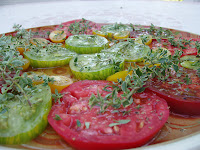 This is both a report and an apology. Repology, perhaps? The apology part is straightforward. I haven't blogged in over a week, mostly due to not having much in the way of picture-worthy stuff. I have an overabundance of tomatoes, but most of them are starting to get squishy, and thus not terribly photo worthy. The dishes I've been making with them, like tabouli and normal, run-of-the-mill beef tacos, aren't really exciting. It's getting to the end of the season, and I've kindasorta stopped weeding, so overall pictures aren't so nice. I guess the peppers are starting to turn color, so that'll likely be my next blog. That, or another on eggplants. Man, those have been doing better than I ever could have expected!
This is both a report and an apology. Repology, perhaps? The apology part is straightforward. I haven't blogged in over a week, mostly due to not having much in the way of picture-worthy stuff. I have an overabundance of tomatoes, but most of them are starting to get squishy, and thus not terribly photo worthy. The dishes I've been making with them, like tabouli and normal, run-of-the-mill beef tacos, aren't really exciting. It's getting to the end of the season, and I've kindasorta stopped weeding, so overall pictures aren't so nice. I guess the peppers are starting to turn color, so that'll likely be my next blog. That, or another on eggplants. Man, those have been doing better than I ever could have expected!But on to the report section. My wife and I have been thinking about getting a dog for months, if not years, but decided against it for a few reasons. Sunday, however, we passed a local pet charity outside of Petsmart with a bunch of dogs for adoption, and it's there that we met Inara. Half beagle, half lab (I like to think the beagle was the male for the sake of hilarity) and all cuteness, she was abandoned down in Southeast Ohio, and the foster parents named her after a escort-for-kings character on Firefly, a show my wife and I both like, because he thought she was a good companion. Well, that was such an amusing reason that we had to keep the name.
Of course, we got her on the day that Hurricane Ike came through, so that has created some hilarity of its own in dodging the massive debris that's fallen down in the yard, and going out at 1AM in 60 mph winds so she can pee. Ike did some fair damage to my garden, unfortunately, knocking down two tomato stakes, knocking two or three green tomatoes off the stalks, cracking the stem of my brandywine, and knocking flat a few of my pepper plants. I just simply don't have the time (or energy, frankly) to go out there and fix things, however, due to this bundle of energy. I had to walk her for over a mile before she'd sleep and allow me to write this entry and get a couple things done around the house. This dog is going to either get me in shape, or gnaw my hand off.














